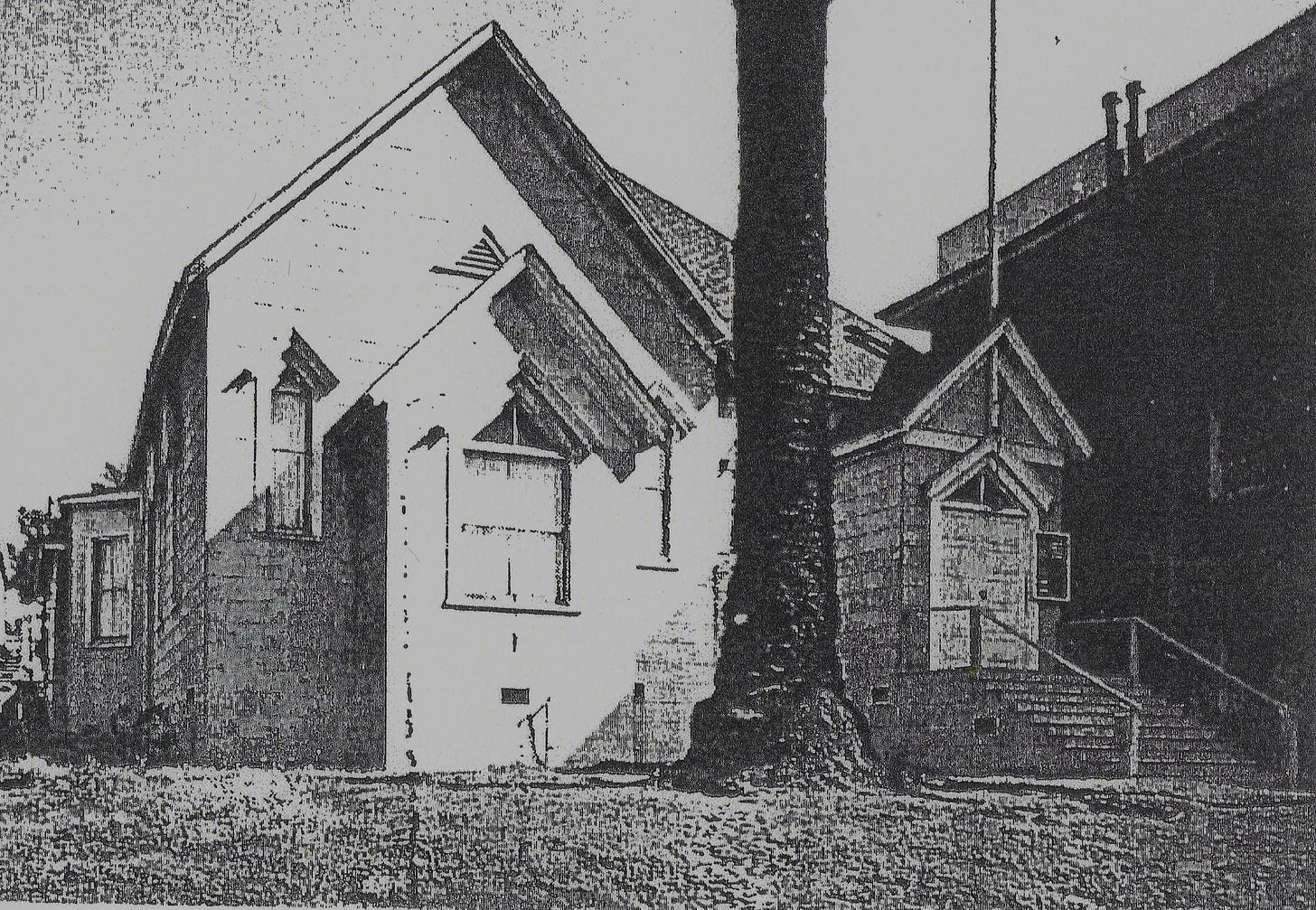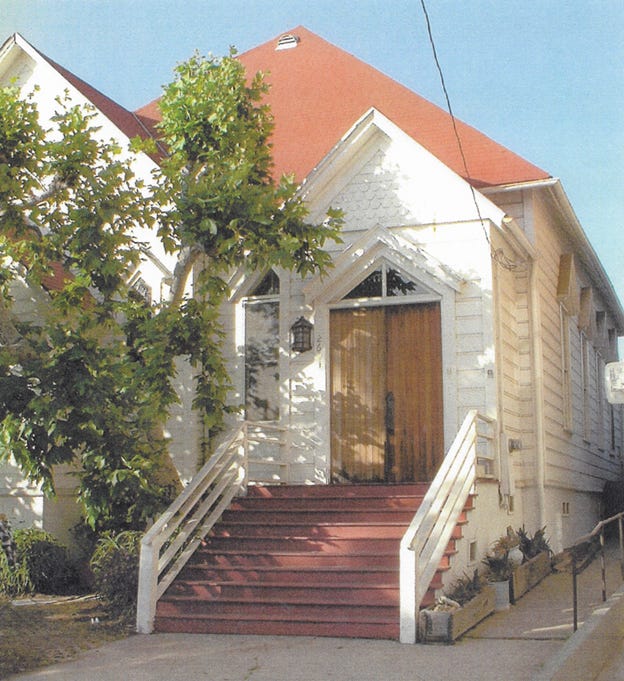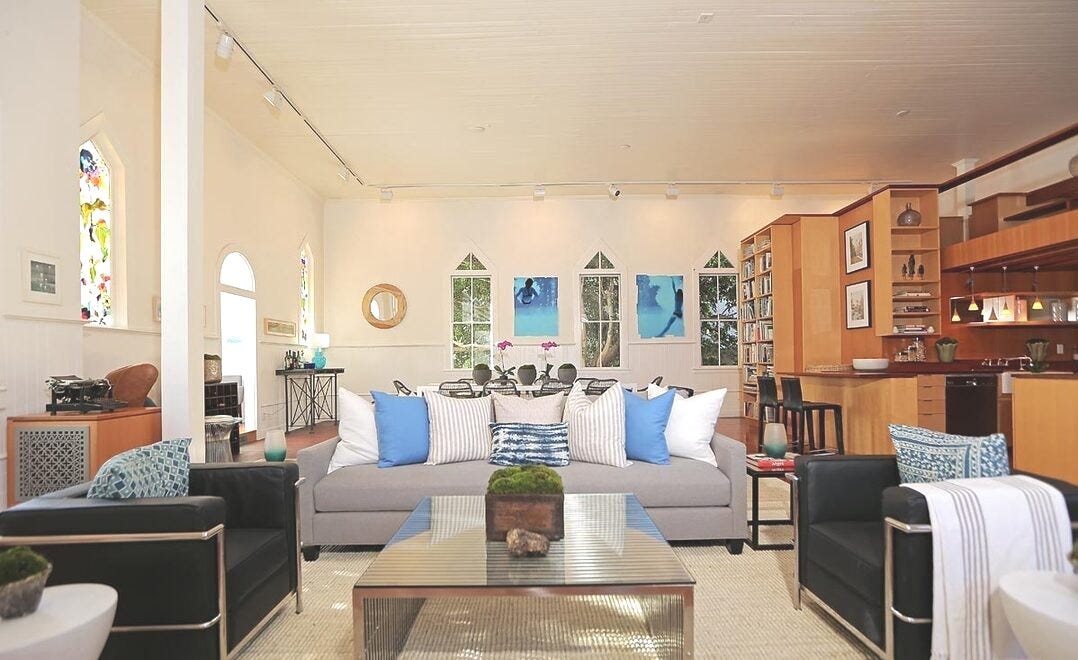In 1900, a small wood-frame Methodist church building located in Santa Monica is moved to Ocean Park. The relocated building (with additions) functions as the Ocean Park Methodist Episcopal Church until 1923, when it becomes a meeting hall for Civil War veteran groups. In 1972, the building is converted into a private residence.
Ocean Park Methodist Episcopal Church (1900 - 1923)
In 1899, the First Methodist Episcopal Church of Santa Monica resolves to donate their 1875 wood-frame church building1 to the Ocean Park M-E Church. After some indecision,2 in September 1900, the old church is moved to its present location3 at 2621 2nd St.4 The Ocean Park M-E Church begins using the building in December 1900.
In 1902, to increase the seating capacity from 100 to 225, the building was enlarged at a cost of $1,200. The building is enlarged again in 1903. In 1907, an unused gymnasium building5 is moved to the rear (east end) of the church property. In 1908, with the burning of Washington School, this rear annex (and the rear rooms of the church) is used for temporary school rooms.
Patriotic Hall (1923 - 1971)
In March 1923, to secure funds for their new church building on the corner of 2nd and Hill, the Ocean Park M-E Church sells the 2621 2nd St property.6 The buyers are the Stephen Jackson7 Post No. 1918 of the Grand Army of the Republic9,10 and the Stephen Jackson Women's Relief Corps11 No. 124 of the Grand Army of the Republic Auxiliary. They intend to use the building as a meeting hall for themselves and for other community organizations, and it is renamed “Patriotic Hall.”12
The Stephen Jackson Post No. 191 GAR is disbanded in 1938, and the Stephen Jackson Women’s Relief Association acquires sole ownership of the property.13 By the early 1970s, the once 400-member-strong Stephen Jackson Women’s Relief Corps is down to 19 members, and they list the building for sale.
Helen Sheats (1972 - 2003)
In 1972, the vacant and deteriorated structure is purchased by artist Helen Sheats,14 who converts it into a residence and artist’s studio. Sheats creates the stained glass windows, which remain to this day. Her purchase of the building saves it from demolition.15 The building is a contributing structure to the 3rd Street Neighborhood Historic District and is designated a City landmark in 1977. Sheats dies in 1999, and the house becomes a rental for a few years before it is put on the market.
Anne Troutman (2004 - 2015)
In 2004, architect Anne Wilcox Troutman buys the property, and reconfigures the building as her family residence. The building is completely rehabilitated, many original architectural elements are restored, and interior residential features are newly created.
The 1875 wood-frame Gothic Revival church building of the First Methodist Episcopal Church of Santa Monica is likely the oldest surviving wooden structure in the city today. It is the first dedicated church building of any denomination to be erected in Santa Monica. The building is originally located at 6th and Arizona, then in 1883, it is moved to 4th and Arizona.
After resolving to donate the church building in late 1898, the Santa Monica Methodists reconsider. In April 1899, they decide to retain the church building. By December 1899, they decide to sell it – but then finally, the Santa Monica Methodists go back to their original plan and donate the old church to the Ocean Park Methodists.
In the summer of 1900, Mary Ellen Leavitt (1836 – 1928), daughter of W.D. Vawter, and her daughter Florence Mary Leavitt (1865 – 1924) sell the vacant 50-ft x 130-ft Lot 14 of Block N of Vawter’s Ocean View Tract to the Ocean Park Methodist Episcopal Church for $250.

From 1886 to 1917, 2nd St is named Lake St, and then from 1917 to 1970 is named Washington Blvd.
The gymnasium building belongs to the Boys’ Success Club - a successful but short-lived (1904 - 1905) endeavor of the Ocean Park M-E Church.
In March 1923, the Ocean Park M-E Church sells this property at 2621 2nd St and also its parsonage property on the corner of 3rd St and Beach.
The Stephen Jackson Post No. 191 of the GAR is formed in May 1907. The post is named for Pvt Stephen Jackson (1846 – 1898), Company F, 64th IL Infantry "Yates Sharpshooters." Jackson, a popular local veteran, dies in Santa Monica. His son, Stephen H. Jackson (1876 - 1950), is a long-time Santa Monica deputy sheriff. The founding commander of the Stephen Jackson post is Robert Dollard, and the senior vice-commander is Alvin Archer. There are thirty-six charter members. The Stephen Jackson Post No. 191 is disbanded in May 1938.
The GAR is organized into "Departments" at the state level and "Posts" at the community level. Posts are assigned a sequential number based on their admission into the state's GAR organization, and most posts hold informal names which honor comrades, battles, or commanders.
The Grand Army of the Republic (GAR) is a fraternal organization composed of veterans of the Union Army, Union Navy, and the Marines who served in the American Civil War. The Grand Army of the Republic (GAR) quickly becomes the preeminent veterans' organization.
No denomination is more active in supporting the Union than the Methodist Episcopal Church. For many Methodists, the victory of Lincoln in 1860 heralds the arrival of the kingdom of God in America.
The Women’s Relief Corps (WRC) is founded in 1883 as the official women's auxiliary to the Grand Army of the Republic. The GAR is created as a "fraternal" organization and refuses to allow women to join until the creation of this auxiliary. The WRC organization is designed to assist the GAR and provide post-war relief to Union veterans. The group also focuses on cemetery maintenance and erecting war memorials.
WRC organizations in Los Angeles, Long Beach, and Pasadena all name their meeting place “Patriotic Hall.”
From about 1935 to 1945, custodian Alvah Busick(1881 - 1952) lives in the rear of the property.
Helen Caroline Johnson Taylor Sheats (1910 - 1999). Born in Chicago. In 1932, Helen marries Vern Taylor (1903 - 1940) and moves to Madison, WI. There in Shorewood Hills, she designs and builds her first house - the Taylor House. In 1942, she marries Paul Henry Sheats (1907 - 1984) and moves to Los Angeles when he joins the UCLA faculty. Helen resumes her interest in modern architecture. She works with John Lautner to design four residences and build two. One is an innovative apartment building near the UCLA campus (1950), and the other is a home in the hillside section of Beverly Hills (1963). After Helen and Paul divorce, she pursues art on a full-time basis. Her neo-Fauvist work is characterized by an intense and vibrant vision of the world.
According to Helen Sheats, she beats out a buyer who intends to demolish the hall and build six residential units.










